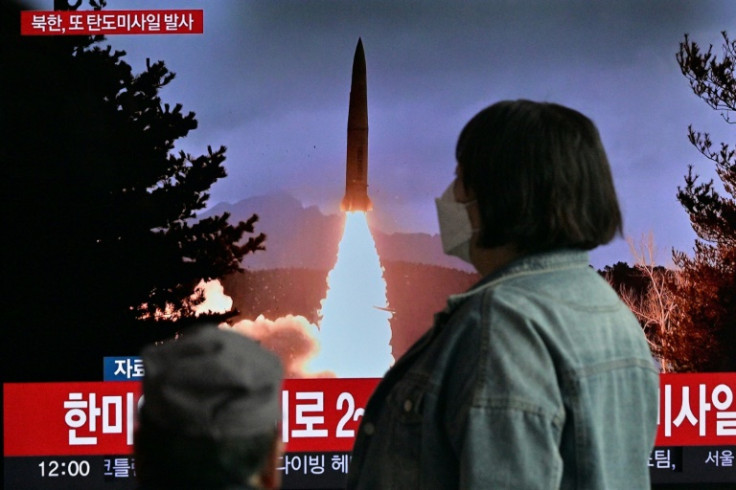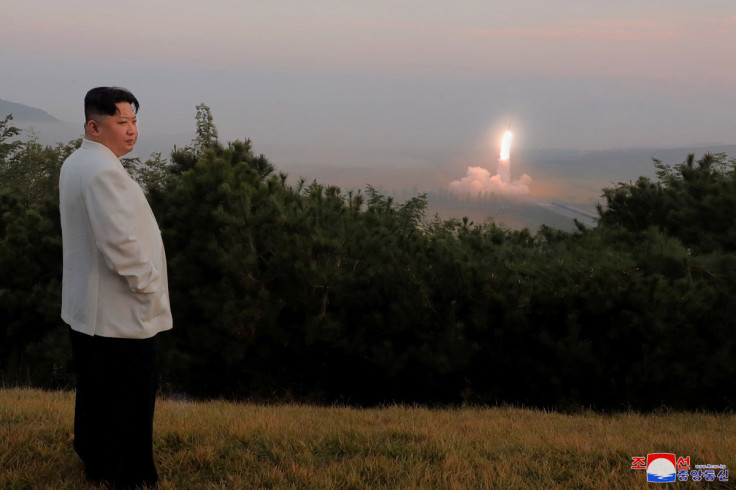Kim Jong Un's Daughter Supervises Test Of 'New Type' Of 'Horror' Ballistic Missile

KEY POINTS
- Kim Jong-Un and his 10-year-old daughter attended the launch of Hwasong-18 on Thursday
- KCNA claimed Hwasong-18 significantly changed North Korea's nuclear weapons program
- Kim warned North Korea's adversaries of "fatal counter-actions" with the new ICBM
Kim Ju Ae, the 10-year-old daughter of North Korean leader Kim Jong-Un, joined her father in supervising the test launch of the country's first solid-fuel intercontinental ballistic missile (ICBM) on Thursday.
A photo obtained by Yonhap News Agency from the North Korean state-run Korean Central News Agency (KCNA) showed Kim and his daughter witnessing the test launch of the country's newest ICBM called "Hwasong-18."
North Korean state media on Friday described the test as a "miraculous success," saying it would "deter invasions and preserve the country's safety as its most powerful method," Al Jazeera reported.
"The development of the new-type ICBM Hwasongpho-18 will extensively reform the strategic deterrence components of the DPRK, radically promote the effectiveness of its nuclear counterattack posture and bring about a change in the practicality of its offensive military strategy," the North Korean state media said, according to KCNAwatch.
Kim reportedly threatened North Korea's main adversaries with the new ICBM, saying it would "constantly strike extreme uneasiness and horror into them by taking fatal and offensive counter-actions."
KCNA argued that North Korea's enemies continue their military aggression, which undermines the peace and stability of the Korean peninsula.
Ankit Panda, an expert with the Carnegie Endowment for International Peace, said the latest ICBM launch showed the progress of North Korea's nuclear weapons production.
"This is a significant breakthrough for the North Koreans, but not an unexpected one," Panda said.
Panda said Hwasong-18 would deprive South Korea and the U.S. of valuable time to respond since it is ready to use and could be quickly mobilized in times of crisis.
North Korea's latest ICBM test caused an alarm in Japan, despite Pyongyang stating that it considered the safety of its neighboring countries during the launch.
It prompted the Japanese government to issue a shelter-in-place alert to the residents on the northwestern island of Hokkaido. However, Japan retracted its missile alert after it assessed the missile didn't reach Hokkaido.
On Monday, the Institute for Science and International Security published a new study stating that North Korea has increased its nuclear arsenal by 75% since 2017.
The report claimed that North Korea can now deploy an average estimate of 45 nuclear weapons and has been increasing its arsenal by an average rate of about six new nuclear weapons per year.
The think tank estimated North Korea could have as many as 96 simple nuclear warheads and up to 63 more powerful thermonuclear weapons.
North Korea continues to develop its nuclear weapons despite being slapped with sanctions by the U.N. Security Council since 2006.
U.N.-imposed sanctions include banning North Korea from arms and military equipment trade, freezing the assets of individuals involved in the country's nuclear program and an export ban on electrical equipment, coal, minerals and other products, according to the Center on Foreign Relations.
The U.S., South Korea, Japan and the E.U. also imposed sanctions against North Korea due to its nuclear program.

© Copyright IBTimes 2025. All rights reserved.






















